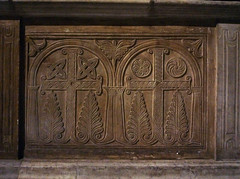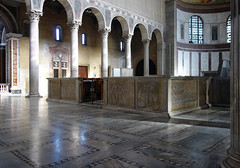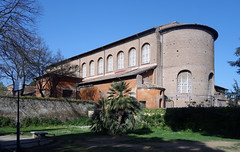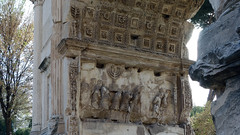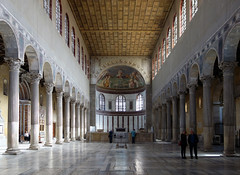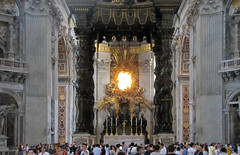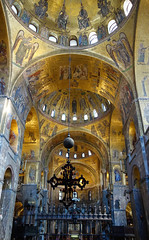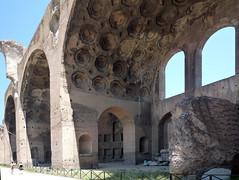6.2: Christianity and art
- Page ID
- 67075
\( \newcommand{\vecs}[1]{\overset { \scriptstyle \rightharpoonup} {\mathbf{#1}} } \)
\( \newcommand{\vecd}[1]{\overset{-\!-\!\rightharpoonup}{\vphantom{a}\smash {#1}}} \)
\( \newcommand{\dsum}{\displaystyle\sum\limits} \)
\( \newcommand{\dint}{\displaystyle\int\limits} \)
\( \newcommand{\dlim}{\displaystyle\lim\limits} \)
\( \newcommand{\id}{\mathrm{id}}\) \( \newcommand{\Span}{\mathrm{span}}\)
( \newcommand{\kernel}{\mathrm{null}\,}\) \( \newcommand{\range}{\mathrm{range}\,}\)
\( \newcommand{\RealPart}{\mathrm{Re}}\) \( \newcommand{\ImaginaryPart}{\mathrm{Im}}\)
\( \newcommand{\Argument}{\mathrm{Arg}}\) \( \newcommand{\norm}[1]{\| #1 \|}\)
\( \newcommand{\inner}[2]{\langle #1, #2 \rangle}\)
\( \newcommand{\Span}{\mathrm{span}}\)
\( \newcommand{\id}{\mathrm{id}}\)
\( \newcommand{\Span}{\mathrm{span}}\)
\( \newcommand{\kernel}{\mathrm{null}\,}\)
\( \newcommand{\range}{\mathrm{range}\,}\)
\( \newcommand{\RealPart}{\mathrm{Re}}\)
\( \newcommand{\ImaginaryPart}{\mathrm{Im}}\)
\( \newcommand{\Argument}{\mathrm{Arg}}\)
\( \newcommand{\norm}[1]{\| #1 \|}\)
\( \newcommand{\inner}[2]{\langle #1, #2 \rangle}\)
\( \newcommand{\Span}{\mathrm{span}}\) \( \newcommand{\AA}{\unicode[.8,0]{x212B}}\)
\( \newcommand{\vectorA}[1]{\vec{#1}} % arrow\)
\( \newcommand{\vectorAt}[1]{\vec{\text{#1}}} % arrow\)
\( \newcommand{\vectorB}[1]{\overset { \scriptstyle \rightharpoonup} {\mathbf{#1}} } \)
\( \newcommand{\vectorC}[1]{\textbf{#1}} \)
\( \newcommand{\vectorD}[1]{\overrightarrow{#1}} \)
\( \newcommand{\vectorDt}[1]{\overrightarrow{\text{#1}}} \)
\( \newcommand{\vectE}[1]{\overset{-\!-\!\rightharpoonup}{\vphantom{a}\smash{\mathbf {#1}}}} \)
\( \newcommand{\vecs}[1]{\overset { \scriptstyle \rightharpoonup} {\mathbf{#1}} } \)
\(\newcommand{\longvect}{\overrightarrow}\)
\( \newcommand{\vecd}[1]{\overset{-\!-\!\rightharpoonup}{\vphantom{a}\smash {#1}}} \)
\(\newcommand{\avec}{\mathbf a}\) \(\newcommand{\bvec}{\mathbf b}\) \(\newcommand{\cvec}{\mathbf c}\) \(\newcommand{\dvec}{\mathbf d}\) \(\newcommand{\dtil}{\widetilde{\mathbf d}}\) \(\newcommand{\evec}{\mathbf e}\) \(\newcommand{\fvec}{\mathbf f}\) \(\newcommand{\nvec}{\mathbf n}\) \(\newcommand{\pvec}{\mathbf p}\) \(\newcommand{\qvec}{\mathbf q}\) \(\newcommand{\svec}{\mathbf s}\) \(\newcommand{\tvec}{\mathbf t}\) \(\newcommand{\uvec}{\mathbf u}\) \(\newcommand{\vvec}{\mathbf v}\) \(\newcommand{\wvec}{\mathbf w}\) \(\newcommand{\xvec}{\mathbf x}\) \(\newcommand{\yvec}{\mathbf y}\) \(\newcommand{\zvec}{\mathbf z}\) \(\newcommand{\rvec}{\mathbf r}\) \(\newcommand{\mvec}{\mathbf m}\) \(\newcommand{\zerovec}{\mathbf 0}\) \(\newcommand{\onevec}{\mathbf 1}\) \(\newcommand{\real}{\mathbb R}\) \(\newcommand{\twovec}[2]{\left[\begin{array}{r}#1 \\ #2 \end{array}\right]}\) \(\newcommand{\ctwovec}[2]{\left[\begin{array}{c}#1 \\ #2 \end{array}\right]}\) \(\newcommand{\threevec}[3]{\left[\begin{array}{r}#1 \\ #2 \\ #3 \end{array}\right]}\) \(\newcommand{\cthreevec}[3]{\left[\begin{array}{c}#1 \\ #2 \\ #3 \end{array}\right]}\) \(\newcommand{\fourvec}[4]{\left[\begin{array}{r}#1 \\ #2 \\ #3 \\ #4 \end{array}\right]}\) \(\newcommand{\cfourvec}[4]{\left[\begin{array}{c}#1 \\ #2 \\ #3 \\ #4 \end{array}\right]}\) \(\newcommand{\fivevec}[5]{\left[\begin{array}{r}#1 \\ #2 \\ #3 \\ #4 \\ #5 \\ \end{array}\right]}\) \(\newcommand{\cfivevec}[5]{\left[\begin{array}{c}#1 \\ #2 \\ #3 \\ #4 \\ #5 \\ \end{array}\right]}\) \(\newcommand{\mattwo}[4]{\left[\begin{array}{rr}#1 \amp #2 \\ #3 \amp #4 \\ \end{array}\right]}\) \(\newcommand{\laspan}[1]{\text{Span}\{#1\}}\) \(\newcommand{\bcal}{\cal B}\) \(\newcommand{\ccal}{\cal C}\) \(\newcommand{\scal}{\cal S}\) \(\newcommand{\wcal}{\cal W}\) \(\newcommand{\ecal}{\cal E}\) \(\newcommand{\coords}[2]{\left\{#1\right\}_{#2}}\) \(\newcommand{\gray}[1]{\color{gray}{#1}}\) \(\newcommand{\lgray}[1]{\color{lightgray}{#1}}\) \(\newcommand{\rank}{\operatorname{rank}}\) \(\newcommand{\row}{\text{Row}}\) \(\newcommand{\col}{\text{Col}}\) \(\renewcommand{\row}{\text{Row}}\) \(\newcommand{\nul}{\text{Nul}}\) \(\newcommand{\var}{\text{Var}}\) \(\newcommand{\corr}{\text{corr}}\) \(\newcommand{\len}[1]{\left|#1\right|}\) \(\newcommand{\bbar}{\overline{\bvec}}\) \(\newcommand{\bhat}{\widehat{\bvec}}\) \(\newcommand{\bperp}{\bvec^\perp}\) \(\newcommand{\xhat}{\widehat{\xvec}}\) \(\newcommand{\vhat}{\widehat{\vvec}}\) \(\newcommand{\uhat}{\widehat{\uvec}}\) \(\newcommand{\what}{\widehat{\wvec}}\) \(\newcommand{\Sighat}{\widehat{\Sigma}}\) \(\newcommand{\lt}{<}\) \(\newcommand{\gt}{>}\) \(\newcommand{\amp}{&}\) \(\definecolor{fillinmathshade}{gray}{0.9}\)Christianity and art
Little is known about Jesus beyond biblical accounts, though we do know more about the cultural and political context in which he lived.
Christianity, an introduction
by DR. BETH HARRIS, DR. STEVEN ZUCKER and DR. NANCY ROSS
How little we know
Almost nothing is known about Jesus beyond biblical accounts, although we do know quite a bit more about the cultural and political context in which he lived—for example, Jerusalem in the first century. What follows is an introductory historical summary of Christianity. It hardly needs stating that there are many interpretations and disagreements among historians.
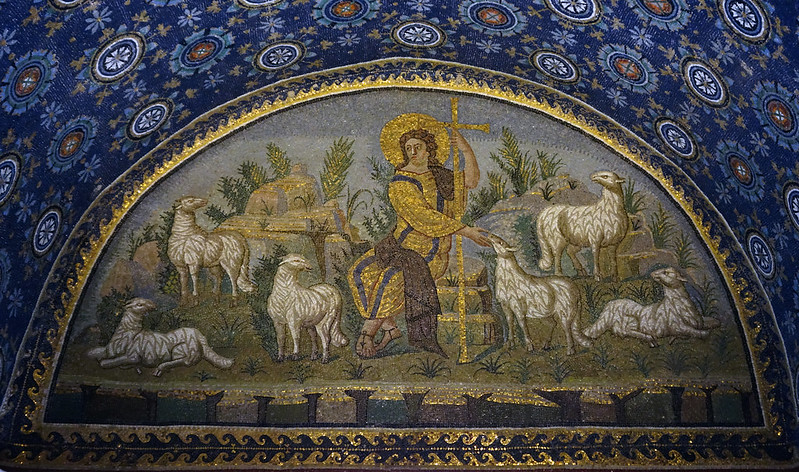
Jesus v. Rome
The biblical Jesus, described in the Gospels as the son of a carpenter, was a Jew and a champion of the underdog. He rebelled against the occupying Roman government in what was then Palestine (at this point the Roman Empire stretched across the Mediterranean). He was crucified for upsetting the social order and challenging the authority of the Romans and their local Jewish leaders. The Romans crucified Jesus, a typical method of execution—especially for those accused of crimes against the government.
Jesus’s followers claim that after three days he rose from the grave and later ascended into heaven. His original followers, known as disciples or apostles, traveled great distances and spread Jesus’s message. His life is recorded in the Gospels of Matthew, Mark, Luke, and John, which are found in the New Testament. “Christ” means messiah or savior (this belief in a savior is a traditional part of Jewish theology).
Old and New Testaments
Early on, there were many ways that Christianity was practiced and understood, and it wasn’t until the second century that Christianity began to be understood as a religion distinct from Judaism (it’s helpful to remember that Judaism itself had many different sects). Christians were sometimes severely persecuted by the Romans. In the early fourth century, the Roman Emperor Constantine experienced a miraculous conversion and made it legally acceptable to be a Christian. Less than a hundred years later, the Roman Emperor Theodosius made Christianity the official state religion.

The first Christians were Jews (whose bible we refer to as the Old Testament or the Hebrew Bible). But soon pagans too converted to this new religion. Christians saw the predictions of the prophets in the Hebrew Bible come to fulfillment in the life of Jesus Christ—hence the “Bible” of the Christians includes both the Hebrew Bible (or the Old Testament) and the New Testament.
In addition to the fulfillment of prophecy, Christians saw parallels between the events of the Hebrew Bible and the New Testament. These parallels, or foreshadowings, are called typology. One example would be Abraham’s willingness to sacrifice his son, Isaac, and the later sacrifice of Christ on the cross. We often see these comparisons in Christian art offered as a revelation of God’s plan for the salvation of mankind.
Different Christianities
Unlike Greek and Roman religions (there was both an official “state” religion as well as other cults), Christianity emphasized belief and a personal relationship with God. The doctrines, or main teachings, of Christianity were determined in a series of councils in the early Christian period, such as the Council of Nicea in 325. This resulted in a common statement of belief known as the Nicene Creed, which is still used by some churches today.
Nevertheless, there is great diversity in Christian belief and practice. This was true even in the early days of Christianity, when, for example, Arians (who believed that the three parts of the Holy Trinity were not equal) and Donatists (who held that priests who had renounced their Christian faith during periods of persecution could not administer the sacraments), were considered heretics (someone who goes against official teaching). Today there are approximately 2.2 billion Christians who belong to a multitude of sects.
The two dominant early branches of Christianity were the Catholic and Orthodox Churches, rooted in Western and Eastern Europe respectively. Protestantism (and its different forms) emerged only later, at the beginning of the sixteenth century. Before that there was essentially just one church in Western Europe—what we would call the Roman Catholic church today (to differentiate it from other forms of Christianity in the West such as Lutheranism, Methodism etc.). Christianity spread throughout the world. In the sixteenth century, the Jesuits (a Catholic order), sent missionaries to Asia, North and South America, and Africa often in concert with Europe’s colonial expansion.
Doctrines
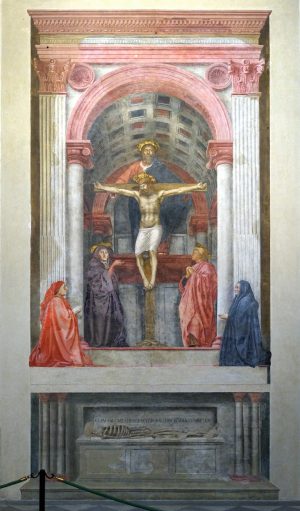
Christianity holds that God has a three-part nature—that God is a trinity (God the father, the Holy Spirit, and Jesus Christ)* and that it was Jesus’s death on the cross—his sacrifice—that allowed for human beings to have the possibility of eternal life in heaven. In Christian theology, Christ is seen as the second Adam, and Mary (Jesus’s mother) is seen as the second Eve. The idea here is that where Adam and Eve caused original sin, and were expelled from paradise (the Garden of Eden), Mary and Christ made it possible for human beings to have eternal life in paradise (heaven), through Christ’s sacrifice on the cross.
Christian practice centers on the sacrament of the Eucharist, which is sometimes referred to as Communion. Christians eat bread and drink wine to remember Christ’s sacrifice for the sins of humankind. Christ himself initiated this practice at the Last Supper. Catholics and Eastern Orthodox believe that the bread and wine literally transform into the body and blood of Christ, whereas Protestants and other Christians see the Eucharist as symbolic reminder and re-enactment of Christ’s sacrifice.
Christians demonstrate their faith by engaging in good (charitable) works (works of art—like the frescoes by Giotto in the Arena Chapel—were often created as good works). They often engage in rituals (sacraments) such as partaking of the Eucharist or being baptized. Traditional Christian churches have a hierarchical structure of clergy. Devout men and women sometimes become nuns or monks and may separate themselves from the world and live a cloistered life devoted to prayer in a monastery.
*There are also nontrinitian Christians.
Smarthistory images for teaching and learning:
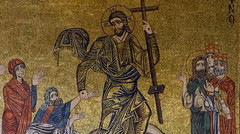


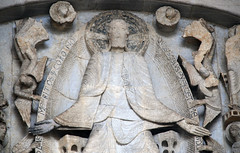

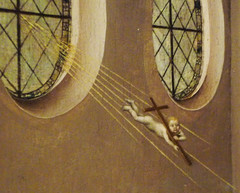
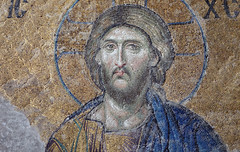
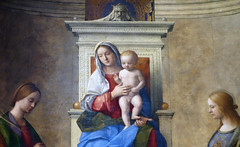
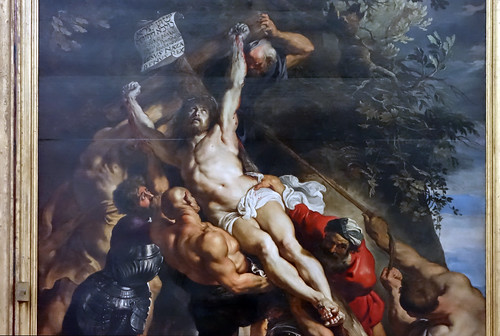

Standard scenes from the life of Christ in art

The Annunciation: The angel Gabriel visits Mary to announce to her that she will be the mother of God. At this moment, Jesus Christ miraculously conceived, and God is made flesh and blood.
The Visitation: Mary and Elizabeth, who are cousins, meet. Mary is pregnant with Jesus and Elizabeth is pregnant with St. John the Baptist. Elizabeth (and her son in her womb) recognize the miracle of Christ in Mary’s womb.

The Nativity: Mary gave birth to Christ in a stable while the animals watched. In works of art, Joseph, Mary’s husband, often sits off to the side and sleeps.

Adoration of the Magi: Three Magi (by tradition, kings from the East), follow a miraculous star that leads them to Christ, who has just been born in a stable. The Magi offer gifts of gold, frankincense, and myrrh (both are aromatic tree resins), and worship the infant Christ.
The Presentation: Mary and Joseph present Christ in the temple at Jerusalem. They encounter Simeon, who was told by the Holy Spirit that he would not die until he had seen the messiah.

The Temptation: Satan visited Christ during his 40 day fast in the wilderness and tempted him to use his powers. In the third and final temptation, Satan asked Christ to worship him, which Christ refused to do.

The Raising of Lazarus: This was one of the many miracles Christ performed that are recorded in the Gospels. Christ was friends with Mary, Martha, and Lazarus, who were siblings. Lazarus became ill and his sisters sent to Christ for help. Lazarus died and was in the grave for four days before Christ raised him from the dead by calling him out of his tomb.

Entry into Jerusalem: Christ rode into Jerusalem on a donkey, where he was greeted by crowds of people. These crowds laid down their cloaks for him and waved palm branches at him, welcoming him into Jerusalem as their leader.
The Last Supper: Christ ate dinner with his apostles and encouraged them to eat bread and drink wine in remembrance of him. He also told the apostles that one of them would betray him.
Agony in the Garden: After the Last Supper, Christ went to pray in the Garden of Gethsemane with his apostles. He asked them to wait and pray with him, but they fell asleep. Jesus prayed alone and bled from every pore.

Kiss of Judas: Judas, who has been paid 30 pieces of silver to betray Christ’s whereabouts to the Roman authorities, leads them to him, and identifies him with a kiss (or an embrace). Christ is arrested by the Romans.
Christ before Pilate: Roman soldiers take Christ to Pilate, the Roman prefect. Pilate tries Jesus, but does not find him guilty. Pilate tells the angry crowd that he will release one prisoner, but they do not choose Jesus. Pilate orders Christ to be whipped and crucified.

The Crucifixion: Christ is crucified at Golgotha as his mother Mary and the apostle John watch. Jesus is offered vinegar and soon dies. He is stabbed with a lance after his death. Pilate gives Joseph of Arimathea permission to take the body of Christ off the cross. Joseph places the body in a tomb and rolls a large stone over the door. Pilate orders guards to watch the tomb.

Descent from the Cross (also known as The Deposition): Christ’s body is taken down from the cross by Nicodemus and Joseph of Arimathea. They bring a shroud for the body. Other figures often included in representations of this scene are the Virgin Mary, St. John the Evangelist and the three Marys (three women mentioned in the Gospels as followers of Christ, all named Mary but not including the Virgin Mary, Jesus’ mother).
The Marys at the Tomb: In one tradition, the three Marys were Mary Magdalene, Mary the mother of James, and Mary Salome, in another, they were the three daughters of St. Anne. They went to the tomb to wash and anoint the body of Christ, but when they got there, the large stone was rolled away from the door. An angel tells the Marys that Christ is not there. Throughout the Middle Ages, this scene signaled the Resurrection of Christ.

The Resurrection: Christ emerges triumphant from the tomb and carries the banner of the resurrection, a white flag with a red cross. This scene was first developed in Early Renaissance art.
Noli me Tangere: Mary Magdalene went to the tomb to mourn Christ. She finds Christ, but initially mistakes him for the gardener. When Mary realizes that he is Christ, he says “Touch me not” or “noli me tangere” in Latin.
The Ascension/Pentecost: After forty days with his followers, Christ ascends into heaven. As he does this, the Holy Spirit descends on them, an event known as Pentecost.
Last Judgment: Christ is often represented in art as judge at the end of time. These scenes often show Christ enthroned in heaven surrounded by apostles and angels, who help him judge the souls of humankind. Good Christians go to heaven, a beautiful orderly place, and the damned go to hell where they are tormented for eternity.
Smarthistory images for teaching and learning:
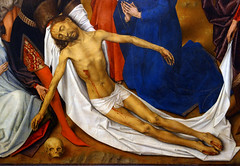

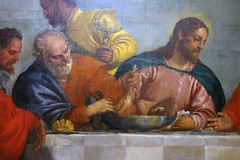
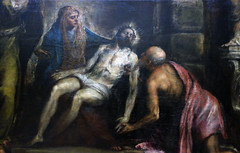
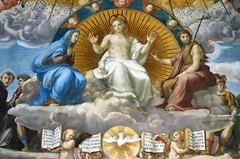
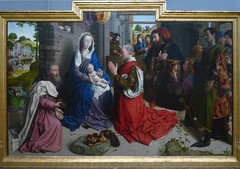

Architecture and liturgy

The relationship between liturgy and architecture—between worship and the space in which it occurs—has a rich history in the Christian tradition. Its roots go back well before the emergence of Christianity to origins in Jewish worship. The term “liturgy” is from a Greek word that means “public service” or “work of the people” and has long been used to describe Christian worship. Today, churches are often described as either “liturgical” (e.g., Catholic, Episcopalian) or “non-liturgical” (e.g., Baptist, Pentecostal) depending on whether or not they use a scripted liturgy (such as the Book of Common Prayer). However, in its most basic sense, a liturgy is simply the order of events in a church service; therefore all churches are liturgical in the sense that all of their services have some kind of structure (welcome, opening prayer, hymn singing, sermon, closing prayer, dismissal, etc.).
Jewish origins
As described in the Jewish Bible (Exodus 25-31), during their exile in the desert, the Israelites made sacrifices to God in the Tabernacle, which was a huge moveable tent. In a large outer court, they made sacrifices, and they burned incense in an inner chamber, dubbed the “Holy of Holies.” The Holy of Holies housed the Ark of the Covenant, which contained the Ten Commandments and the manna (the substance miraculously supplied as food to the Israelites in the wilderness), and was where God chose to reveal his presence. It wasn’t until King Solomon built the Temple in Jerusalem (possibly in the tenth century B.C.E.) that the Jews had a permanent place of worship. Although made of stone, the Temple had a similar layout as the Tabernacle. This Temple was destroyed in 586 B.C.E. and was replaced by the Second Temple (now the location of the Dome of the Rock in Jerusalem, image below).
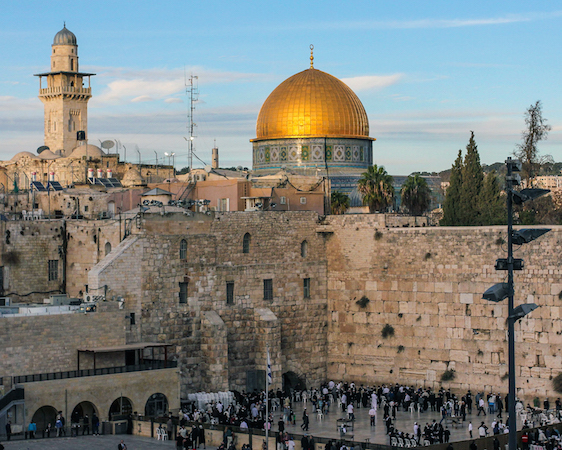
We don’t know much about the details of Temple liturgy, but worship included animal sacrifices, incense burning, chanting of the Psalms, blessings, and the making and eating of the “showbread” (bread placed on a specially dedicated table in the Temple as an offering to God).

After the Roman commander (and later emperor) Titus destroyed the Second Temple in 70 C.E., the Jews were forced to worship only in their synagogues, which were—and remain today—halls for prayer and study (but not sacrifice). In addition to chanting psalms, prayers, and blessings, services in the synagogue also included the reading of scripture and teaching. This was reflected in the synagogue architecture, which included the bema, a platform from which men could read scripture and teach.
Early Christian worship
Many of the first Christians were Jews and so continued and reinterpreted many practices from the Temple and synagogue. We know from early Christian texts, such as the writings of Tertullian, Irenaeus of Lyons, and Justin Martyr, and the Didache (a first or second century text of possible Syrian origins) and the New Testament book of Hebrews that early Christian worship included some type of creedal statement, hymns, prayers, the reading of the Septuagint (the Hebrew Bible translated into Greek), teaching, meals, and baptism.

Before the year 313 C.E., when the emperor Constantine legalized Christianity with the Edict of Milan, Christian worship occurred in homes, at grave sites of saints and loved ones, and even outdoors. One of the earliest existing churches (dating to about 254 C.E.) is found at Dura Europos, a Roman outpost in Syria (sketch of plan, above). This small church had been converted from a typical Roman home, which had a square layout with a courtyard at its center. The church members apparently knocked down one of the walls to create a larger hall for teaching and the celebration of the eucharist for (for Catholics, the miraculous transformation of the bread and wine into the body and blood of Christ). One of the rooms was also turned into a baptistery, which contains some of the earliest surviving Christian frescoes.

Christian use of the Roman basilica
Not long after his conversion and subsequent legalization of Christianity, Constantine began an extensive building campaign to support his new state religion in major cities such as Rome, Jerusalem, and Constantinople. In looking for a structure to address the spatial needs of the developing Christian liturgy (such as increasing congregation size and more elaborate processions), he adapted the Roman basilica, which until that point had been used exclusively as a civic building, like the Basilica of Maxentius and Constantine (above).
Roman basilicas were long rectangular buildings, often with a central nave (a wide, center aisle) and two side aisles. There was at least one semicircular apse, often at one end of the building, in which the magistrates sat and heard their cases. The basilica was in many ways the perfect building to adapt into a church because it did not have the pagan associations that Roman temples did and was large enough to accommodate the growing Christian population.

Early Christian basilicas such as Santa Sabina (above) and San Paolo fuori le Mura (St. Paul’s Outside the Walls) maintained the basic structure of the Roman basilica, but distinctly Christian elements were added. The bema was retained from the synagogue and continued to be used as the raised platform from which priests preached (by the late Middle Ages this was often attached to a pillar to one side of the central aisle of the nave). Many churches added the ambo, an even higher platform, accessed by stairs, from which the Gospel was read and sermons were preached—in which case the bema was reserved for the recitation of prayers and the reading of the Epistles or Old Testament. Another distinctly Christian architectural element was the transept, which was added near the apse-end of the building to form a cross-shape and provide additional space (see the plan below).

Most significant among the Christian additions to the basilica, and the central focus for the liturgy, was the altar upon which the eucharist was celebrated. Altars were located either right in front of or just inside of the apse (as in Santa Sabina, above)—that is, within the Christian equivalent of the Jewish Holy of Holies. Up until the Middle Ages, most altars were wooden table-like structures; they then transitioned into stone. In the early fifth century, the Church formally required the installation of saints’ relics (often bone fragments) in altars. This practice was based in part on the tradition of placing altars on top of martyrs’ tombs (like at St. Peter’s Basilica in Rome) and the text of Revelation 6:9-10, which describes martyrs crying out for justice from under the altar in heaven. The three main areas of the church came to be ascribed with symbolic meaning: the narthex, or entry, was the world; the nave, or main hall, was the Kingdom of God; and the sanctuary, or altar area—like the Holy of Holies—was heaven.

Medieval worship
The structures of both the liturgy and church architecture remained basically the same in the Middle Ages, but became increasingly complex and diverse as Christianity spread throughout the empire. We can think of the liturgy as the script and the church architecture as the stage upon which it was performed (below). The “actors” were the clergy of course, consisting of priests, deacons, and liturgical assistants, but the congregation also had an essential role. They not only participated in the call and response of prayers and hymns in the liturgy and walked in processions within and without the church walls, but they also practiced personal devotion during the celebration of liturgy. It was not uncommon for lay people to move about the building independent of the liturgy in order to pray or light candles at the smaller shrines in a church’s side chapels.

As is still the case in modern churches, liturgy and architecture mutually influenced one another in the Middle Ages. The walls and floors of medieval churches were often covered with plaques and tombs dedicated to church members and saints, as well as images of Christ, Mary, saints, and angels. These images and memorials influenced the movements of the faithful, as they moved about the church interior to venerate their particular favorites. A shrine of a popular or historically important saint would receive more attention, perhaps in the form of donations, and thus would be embellished. Or if, for example, the bones of a saint or martyr were interred in a particular location of the church, others would seek to be buried as close as possible to that tomb, and so on. These are just a few of the many ways in which theology and devotional practice could influence the church environment and vice versa.
There were also areas of the church that were off-limits for the laity (the non-clergy public), most notably the altar area. Initially the use of chancels (below), or waist-high walls, were used to separate the congregation from the altar for very practical reasons like keeping dogs away from the bread and the wine of the eucharist or retaining large crowds on major holidays. However, with time, these partitions were made higher and more ornate, peaking in the late Middle Ages when they often reached the ceiling of the church and completely obstructed the congregation’s view of the altar.

Relics and pilgrimage
Images and relics also influenced religious activity on a much larger scale beyond the walls of the church. Religious pilgrimage had been an important part of Christian devotion since the time of Constantine and his building campaign in the Holy Land and Constantinople (a pilgrimage is a journey to a sacred place). Of course, not everyone was financially or physically able to make such a trek and in response, church architecture and religious objects (such as reliquaries) began to invoke elements of particular pilgrimage sites or recreate pilgrimages on a smaller scale. For example, architectural elements of Holy Land buildings such as the Church of the Holy Sepulcher were often referenced in the churches of Western Europe, or even explicitly invoked, as in the name of the basilica of Santa Croce in Gerusalemme (the basilica of the Holy Cross in Jerusalem) in Rome. Relics of important saints were also used to refocus attention. For instance, the founding of a new political center (say, Charlemagne’s palace and chapel at Aachen) often entailed the relocation of relics to embody divine approval and authority and/or entice pilgrims and visitors.
Spiritual architecture

We should also note that, in a sense, the physical progression of the faithful from the nave of the church to the altar—if and when they participated in the eucharist—was itself a small-scale, local version of a pilgrimage, in which they moved from their present reality to the future promise of heaven. The spiritual understanding of the church and its architecture also impacted the actual design of medieval churches. Biblical passages such as Revelation 21:9-21, which describes a vision of an angel measuring the city of the Heavenly Jerusalem, inspired medieval Christians to ascribe spiritual significance to the dimensions and proportions of church architecture. Revelation 21:9-21 is illustrated, for example, in the eleventh-century manuscript of Beatus of Liébana’s Commentary on the Apocalypse (below), which depicts one angel holding a measuring rod in the city center as twelve angels stand at its twelve gates, visually becoming part of the architecture of the Heavenly Jerusalem. While, in a sense, all medieval churches were understood to be symbolic of the Heavenly Jerusalem, some invoked its imagery more literally, as found in the use of semiprecious stones (cf. Rev. 21:9,19) set into the dado (lower walls) of the chapels of St Catherine and the Holy Cross at Karlstein, and the chapel of Wenceslas in the Prague Cathedral (above).

Another example of spiritual architecture is found in the monastic complex of the Plan of St. Gall (c. 820 C.E.) (below), the exact purpose of which remains a matter of scholarly debate today. Christian monasticism dates back to the desert monks of the fourth century. The monks led lives of poverty, prayer, and asceticism which were formalized in several important guidebooks or “rules”; one of the most influential was the Rule of St. Benedict, which regulated the monks’ lives by hourly prayer and the celebration of the liturgy, or the “offices.” Something of this regulation is visible in the Plan of St. Gall, which depicts more than forty structures, including a church, a scriptorium (a place where monks who were scribes copied books), residence halls, and buildings for preparing and eating food. Grids and squares dominate the Plan’s buildings and gardens, creating a visual sense of order. Regardless of whether its elaborate schematic was intended for the construction of an actual building in the Carolingian empire, it seems that the Plan of St. Gall was meant to be a diagram of the ideal, spiritual monastery.

Mapping time
In short, while there was a broad range of experience and understanding of the church and its liturgy throughout Europe—from the peasant who attended rarely if ever, to the clergy who used and often commissioned buildings and furnishings, to the aristocrats who funded much of medieval monumental art and manuscripts, even to kings and the emperor himself—life in the Middle Ages was measured out by the liturgical calendar. Churches were focal points of the medieval landscape and their ceremonies and processions periodically mapped out the sacred even beyond the church walls.
Additional resources:
More from Smarthistory on pilgrimages and the cult of the relic
Pilgrimage in Medieval Europe on The Metropolitan Museum of Art’s Heilbrunn Timeline of Art History
Dura Europos from the Yale University Art Gallery
Mary Carruthers, The Craft of Thought: Meditation, Rhetoric, and the Making of Images, 400-1200 (New York: Cambridge University Press, 1998).
Allan Doig, Liturgy and Architecture: From the Early Church to the Middle Ages (Burlington, VT: Ashgate, 2008).
Thomas J. Doig and E. Ann Matter, eds. The Liturgy of the Medieval Church, 2nd ed. (Kalamazoo, MI: Medieval Institute Publications, 2005).
Richard Kieckhefer, Theology in Stone: Church Architecture from Byzantium to Berkeley (New York: Oxford University Press, 2005).
Cyrille Vogel, Medieval Liturgy: An Introduction to the Sources. Revised and translated by William G. Storey and Niels Krogh Rasmussen, (O.P. Washington, D.C.: The Pastoral Press, 1986).
James F. White, A Brief History of Christian Worship (Nashville, TN: Abingdon Press, 1993).
Smarthistory images for teaching and learning:
